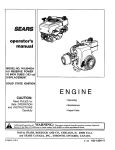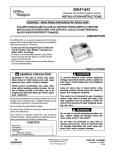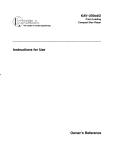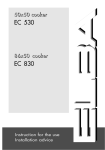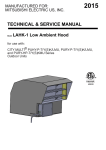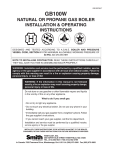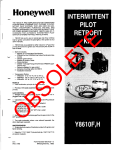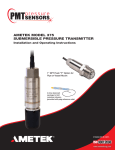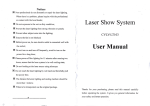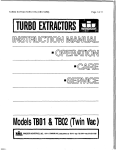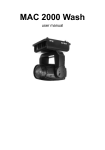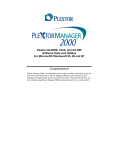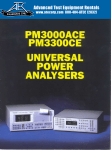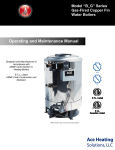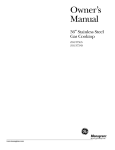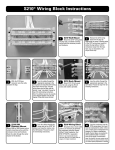Download Honeywell Hot Surface Control - cyb
Transcript
Honeywell - THE S89 AND S890 PROVIDE OPERATING CONTROLAND SYSTEM SHUTDOWN ON LOSS OF MAIN BURNER FLAME IN DIRECT IGNITION CENTRAL HEAT FURNACES AND HEATING APPLIANCES WITH HOT SURFACE IGNITER. 0 S89C,G,J and S890C,G,J combination igniter-sensor. are for systems with a 0 S890D,H and S890D,H are for systems with separate igniter and sensor. 0 S89C,D,J ignition. and S890C,D,J lock out after one try for 0 S89G,H and S890G,H provide three tries for ignition before lockout, with 30 sec. min. purge before second and third tries. 0 S89J and S89OJ provide 2 or 4 sec. (depending model) max. ignition activation periods. on q S890 provides 30 sec. min. prepurge on initial trial for ignition. 0 Compatible with Norton 201 and 271 or equivalent surface igniters. 0 S89D,H and S890D,H require a separate mounted on burner (Q354 recommended). hot sensor •i Available with leadwires for line voltage connections. 0 Available Damper. with Molex plug for connecting D80D Vent Cl Modules can be used on either naturalor LP gas; they provide 100 percent shutoff of gas on lockout. 0 Modules have relay contacts for use with any direct ignition gas control with max. 2.0 A, 24 Vat rating. 0 Modules use rectification principle for flame sensing. 0 Minus 40° F to +175” temperature rating. F [minus 40” C to +79” C] J.A. Form Number 68-6070-l 0 Honeywell Inc. 1989 Rev. 9-89 rating. VR8205, VR845, VR854, VR8450 or VR8540 recommended. HOT SURFACE IGNITER OR IGNITER-SENSOR: Norton Model 201 or 271 or equivalent. ELECTRICAL RATINGS: Voltage and frequency: 20.5 to 28.5 V (24 V nom.), 60 HZ. Current rating: 0.2 A. Gas control contact ratings (at 24 Vat): 2.0 A running, 20.0 A inrush. IGNITER WARM-UP PERIOD: 34 sec., nom. THERMOSTAT ANTICIPATOR SETTING: 0.2 A plus oas control current rating. AMBIENT TEMPERATURE RATING: Minus 40° F to +175“ F [minus 40“ C to +79” C]. RELATIVE HUMIDITY RATING: 5 to 90 percent at 95“ F. FLAME FAILURE RESPONSE TIME: 2 sec. max. with a 2.5 uA flame signal. FLAME CURRENT: 0.8 J.LADC, min. TERMINALS: 114 in. male quick connects for line voltage and sensor connections; 3/l 6 in. male quick connects for all low voltage connections. Terminal options (specify when ordering): 9 Molex plug for connection to D80D Vent Damper. 10 in. [250 mm] min. color-coded leadwires for all line voltage connections. MOUNTING: Mounts in any position. Fasten with No. 6-32 machine or No. 8 sheetmetal screws, 1 in. long. DIMENSIONS: See Fig. 1. UNDERWRITERS LABORATORIES INC. COMPONENT RECOGNIZED: FILE NO. MP268, Guide No. MCCZ2. CANADIAN GAS ASSOCIATION CERTIFIED: 1029-ABI6218. AMERICAN GAS ASSOCIATION CERTIFIED: 20-2081. NOTE: If igniter other than Norton Model 201 or 271 is used, the igniter must meet the following minimum specifications, required over the life of the igniter: Igniter must reach 1000” C 11832’ Fj within 34 seconds with 102 Vat applied. Igniter must maintain at least 500M ohms insulation resistance between the igniter leadwires and the igniter mounting bracket. Igniter must not develop an insulating layer on its surface (over time) which would prevent flame sensing. Igniter surface area immersed in flame must not exceed 1/4of the grounded area immersed in flame. This would prevent flame sensing. Igniter current draw at 132 Vat must not exceed 5 A. SENSOR: Separate sensor required for all S89D,H and S890D,H. Honeywell 0354 recommended. IGNITER WIRING: Provide wiring harness to suit application. Leadwires: No. 18 AWG, stranded copper with 105O C rated l/l 6 in. PVC insulation. Terminals: Insulated 114 in. female quick connects or solderless connectors to module (depending on module) and suitable connector to igniter. TRANSFORMER: Add current ratings of module, gas control, vent damper and any other components of the control system to determine transformer size requirement. THERMOSTAT: Compatible with any Honeywell 24 V thermostat and with competitive 24 V thermostats that are powered independently of the module. HIGH LIMIT AND OTHER AUXILIARY CONTROLS: As specified by the heating appliance manufacturer. l l l OTHER SYSTEM CONTROLS The S89 and S890 provide operating control of a direct ignition system using a hot surface igniter. Additional components required to complete the system must be ordered separately. They include: DUAL VALVE COMBINATION GAS CONTROL: Any direct ianition aas control with 2.0 A max. main valve 5 IN.O.C.(6) !!A $IN. Q.C. (5) [I34 i A 1 MOLEX PLUG AND TH-W TERMINAL ON VENT A SENSE MODELS A 3 DAMPER TERMINAL ONLY. ONLY. LEADWIRE LEADWIRES VOLTAGE MODELS ON D AND H MODELS HAVE 4 IN PLACE OF LINE TERMINALS. FIG. l-APPROXIMATE S89/S890 DIMENSIONS 3 IN In. [mm IN BRACKETS]. 68-0070-l Any control should be replaced if it does not perform properly on checkout or troubleshooting. In addition, replace any module if it is wet or looks like it has ever been wet. Disconnect power supply before beginning wiring to prevent electrical shockorequipment damage. If a new gas control is to be installed, turn off gas supply before starting installation. Conduct Gas Leak Test according to gas control manufacturer’s instructions after the gas control is installed. lf module must be mounted near moisture or water, provide suitable waterproof enclosure. L MOUNT IGNITION MODULE Select a location close enough to the burner to allow a short, direct cable route to the igniter. Ambient temperature at the module must be within the range of minus 40” F to plus 175” F [minus 40” C to plus 79” C]. The module must be protected from water, moisture, corrosive chemicals and excessive dust and grease. The module can be mounted in any position. Fasten securely with four No. 6-32 machine or No. 8 sheetmetal screws 1 in. [25 mm] long. PERFORM PREINSTALLATION SAFETY INSPECTION If this is a replacement installation, check the appliance and venting system carefully before installing new module. If a condition which could result in unsafe operation is detected, the appliance should be shut off and the owner advised of the unsafe condition. Any potentially unsafe condition must be corrected before proceeding with the installation. MOUNT THE SYSTEM CONTROLS Mount any required controls, such as the gas control, hot surface igniter, flame sensor, thermostat, limit and transformer according to manufacturer’s instructions. MAINTENANCE REQUIREMENTS IN SEVERE ENVIRONMENTS Regular preventive maintenance is important in any application, but especially so in agricultural and industrial applications because In many such applications, the equipment operates 1OO,OOO-200,000 cycles per year. Such heavy cycling can wearoutthegascontrolinonetotwoyears. A normal forced air furnace, for which the controls were originally intended, typically operates less than 20,000 cycles per year. Exposure to water, dirt, chemicals, and heat can damage the module or the gas control and shut down the control system. A NEMA 4 enclosure can reduce exposure to environmental contaminants. See Electronic Ignition Service Manual, form 706604. The maintenance program should include regular checkout of the system as outlined under Checkout, page 11. l I l and cleaning 1. All wiring must comply with applicable electrical codes and ordinances. 2. When installing the hot surface igniter, the leadwires should be kept as short as possible and should not be allowed to rest against grounded metal surfaces. 3. A common ground is required for the S89/S890 and the main burner. The 24 V (GND) terminal internally grounds one side of the transformer. Any auxiliary controls or limits must not be in the grounded leg. In addition, the appliance should be earth-grounded. 4. Make sure thetransformer has adequate VA. The ignition module requires at least 0.2 A at 24 Vat. Add the current draws of all other devices in the control circuit, including the gas control, and multiply by 24 to determine the total VA requirement of these components. Add this total to 4.8 VA (forthe ignition module). The result isthe minimum transformer VA rating. Use a Class II transformer if replacement is required. 5. Check that Ll (hot) and L2 (neutral) are wired to the proper terminals. If Ll and L2 are interchanged, the S89/S890 will not detect the flame, and will go into safety shutdown. may Maintenance frequency must be determined individually for each application. Some considerations are: Cycling frequency. Appliances that may cycle more than 20,000 times annually should be checked monthly. Intermittent use. Appliances that are used seasonally should be checked before shutdown and again before the next use. 9 Consequence of unexpected shutdown. Where the cost of an unexpected shutdown would be high, the system should be checked more often. Dusty, wet, or corrosive environment. Since these environments can cause the controls to deteriorate more rapidly, the system should be checked more often. Protective enclosures, as outlined under “Planning the Installation”, are recommended regardless of checkout frequency. l l Connect Igniter Prepare wiring harness. See Igniter wiring, page 3. 1. On models with quick connects, use insulated 114 in. female quick connects to connect the wiring harness leads to the HSI terminals on the ignition module. 2. On models with leadwires, use solderlessconnectors to connect the wiring harness leads to the blue leads from the module. 3. Connect the wiring harness to the igniter. l 1 I IMPORTANT FIRE OR EXPLOSION HAZARD MAY CAUSE PROPERTY DAMAGE, SEVERE INJURY OR DEATH Do not attempt to take the module apart or to clean it. Improper reassembly cause unreliable operation. 1. Check the wiring diagram furnished by the appliance manufacturer, if available, for circuits differing from the wiring hookups shown. Carefully follow any special instructions affecting the general procedures outlined below. 2. Disconnect the power supply before making wiring connections to prevent electrical shock or equipment damage. 5 68-007&l Connect Vent Damper should not be used in a fan-assisted combustion system or an LP gas system and that the vent damper plug must not be removed except to connect a D80D with the plug-in cable. S89D,H/S890D,H with separate igniter and sensor can be substituted inthesehookupsbysimplyconnectingthesensoras shown in Fig. 3. 2. Refer to heating appliance manufacturer’s instructions for wiring auxiliary controls. 3. Adjust thermostat heat anticipator to match system current draw. The current draw equals the total current required for the ignition module (0.2 A) plus the gas control and any other auxiliary equipment in the control circuit. The D80B Vent Damper can be used with all ignition modules, although the Molex plug provided on some modules simplifies wiring connections when used with the D80D Plug-In Vent Damper. Once a module with vent damperplug has powered a vent damper circuit, it cannot be used in a gas system without a vent damper. A nonreplaceable fuse in the module blows on initial power-up. Oncethisfuse has blownthemodulewon’tworkunlessthe vent damper is connected. To connect the plug-in model to D80D: 1. Remove the plug from the terminal strip on the ignition module case and discard. 2. Using the wiring harness supplied, insert the matching pin plug into receptacle on case and other end to vent damper. To connect the D808, follow the wiring diagrams sup plied with the vent damper or see Fig. 5 for typical connections. Connect Gas Control Use No. 18 gauge solid or stranded wire. Use 3/l 6 in. femalequickconnectsfor moduleconnections. Connectto gas control terminals as shown in wiring diagrams, using terminals appropriate to the gas control. Connect Ignition Module Ground Control System 1. Connect remaining system components to the ignition module terminals as shown in the appropriate wiring diagram, Figs. 2 to 10. Figs. 2 and 3 are basic circuits for a heating only atmospheric burner system. Fig. 2 shows the C,G and J models with combination igniter-sensor; Fig. 3 shows the D,H models with separate igniter and sensor. Figs. 4 and 5 show the C,G and J models with a D80 Vent Damper. Never use a vent damper in an LP gas system or in a fan-assisted combustion system. Figs. 6-10 show S89C,G,J/S890C,G,J with combination igniter-sensor in a variety of systems, with alternate connections for vent damper plug models. Remember, however, that a vent damper The igniter, flame sensor and ignition module must share acommon ground with the main burner. Use thermoplastic insulated wire with a minimum rating of 105O C [221 o Fj for the ground wire; asbestos insulation is not acceptable. If necessary, use ashield to protect the wire from radiant heat generated by the burner. Connect the ground wire as follows: 1. Fii one end of the ground wire with a female 3/l 6 in. quick-connect terminal and connect it to the male quickconnect GND(BURNER) terminal on the ignition module. 2. Strip the other end of the wire and fasten it under the igniter bracket mounting screw. If necessary, use a shield to protect the ground wire from radiant heat. 3. The burner serves as the common grounding area. If there is not good metal-to-metal contact between the burner and ground, run a lead from the burner to ground. l l l DUAL VALVE COMBINATION GAS CONTROL S69C.G.J/S89OC.G.JHOT SURFACE IGNITIONCONTROL THERMOSTAT OR CONTROLLER A A POWER SUPPLY. PROVIDE DISCONNECT MEANS AND OVERLOAD PROTECTIONAS REQUIRED. MAKESURE Ll AND L2 ARE NOT REVERSED; THIS WOULD PREVENT FLAMEDETECTION. A A 4 ALERNATE LIMITCONTROLLERLOCATION. CONTROLS IN 24V CIRCUIT MUST NOT BE IN GROUND LEG TO TRANSFORMER. FOR MODULEWITH TH-W TERMINALAND VENT DAMPER PLUG. JUMPERM-W AND 24V TERMINALS.DO NOT REMOVE VENT DAMPERPLUG. FACTORYTESTTERMINAL. DO NOT USE. M2190 FIG. 2-S89C, LEADWIREMODEL IS COLOR-CODEDAS SHOWN. i G, J AND S89OC, G, J IN AN ATMOSPHERIC BURNER HEATING SYSTEM. 6 - DUAL VALVE COMBINATION SBW.HIS89OD.H GAS CONTROL IGNITION HOT SURFACE CONTROL DAMPER PLUG THERMOSTAT OR CONTROLLER A 1 POWER SUPPLY. AND OVERLOAD PROVIDE THIS WOULD PREVENT ALTERNATE it CONTROLS GROUND DISCONNECT PROTECTION MAKE SURE Ll AND L2ARE FLAME 4 DETECTION. LIMIT CONTROLLER IN 24V CIRCUIT A A A MEANS AS REQUIRED. NOT REVERSED; LOCATION. FOR MODULE JUMPER WITH TH-W TERMINAL M-W FACTORY AND 24V TERMINALS. TEST TERMINAL. LEADWIRE MODEL AND VENT DAMPER DO NOT REMOVE PLUG, VENT DAMPER IS COLOR-CODED AS SHOWN. MUST NOT BE IN M2200 LEG TO TRANSFORMER. FIG. 3-S89D,H PLUG. DO NOT USE. AND S890D,H IN AN ATMOSPHERIC BURNER HEATING SYSTEM. DUAL VALVE S99C.G,JiS89OC.G.J COMBINATION HOT SURFACE DSOD VENT DAMPER CONTROLLER OR CONTROLLER A A AND PROTECTION Q CONTROLS 1 POWER SUPPLY. ALTERNATE GROUND PROVIDE DISCONNECT MEANS A REMOVE LIMIT CONTROLLER IN 24V CIRCUIT LOCATION. MUST NOT SE IN LEG TO TRANSFORMER. PLUG ONLY IF USING STARTUP WHEN OPERATE ONLY WHEN A FACTORY TEST TERMINAL. A LEADWIRE AS REQUIRED. FIG. 4-S89C, G, J AND S89OC, G, J IN AN ATMOSPHERIC DAMPER. 7 MODEL BURNER VENT DAMPER. PLUG IS REMOVED; VENT DAMPER THEN FUSE SLOWS ON MODULE WILL IS CONNECTED. Do NOT USE. IS COLOR-CODED HEATING AS SHOWN. M2191 SYSTEM WITH THE D80D VENT 68-007&l THERMOSTAT DUAL VALVE OR COMBINATION SS9C.G.JlS89OC.G.J HOT CONTROLLER GAS CONTROL SURFACE CONTROL IGNITION - IGNITERSENSOR I I I I J J IP= \ BURNER GROUNIJ A LIMIT LIMIT C-ZZNTRnl I FR CONTROLLER II I TRANSFORMER n 1 POWER SUPPLY. AND OVERLOAD A ALTERNATE GROUND DISCONNECT IN 24V CIRCUIT A MEANS FOR MODULE AS RECUIRED. LIMIT CONTROLLER CONTROLS A PROVIDE PROTECTION JUMPER A A LOCATION. MUST NOT BE IN LEG TO TRANSFORMER. FACTORY A WITH TH-W TERMINAL TH-W AND 24V TERMINALS. TEST TERMINAL. LEADWIRE MODEL CONNECT COLORS AND VENT DAMPER DO NOT REMOVE PLUG. VENT DAMPER PLUG. DO NOT USE. IS COLOR-CODED AS SHOWN. OF WIRE AS SHOWN. M2192 FIG. S-S89C, G, J AND S89OC, G, J IN AN ATMOSPHERIC BURNER HEATlNG SYSTEM WITH D80B VENT DAMPER. DUAL VALVE COMBINATION SS9C.G.JlS89OC.G.J HOT GAS CONTROL SURFACE CONTROL IGNITION I HOT _I AIR DAMPER PROVING SWITCH T OA I_ 0 . . 1 N--L1 A PLUG _t (HOT) I” b- A . . b r---7 *; 4-L2 COMSUSTlON COMBUSTION AIR BLOWER AIR SLOWER MOTOR n 1 RELAY POWER SUPPLY. PROVIDE AND OVERLOAD A A ALTERNATE POWER PREVENT MEANS DETECTION. LIMIT CONTROLLER LOCATION. SUPPLY. PROVIDE DISCONNECT PROTECTION FIG. 6-S89C,G,J A AS REQUIRED. FLAME AND OVERLOAD Ls Ll (HOT) !‘* L2 x THERMOSTAT CONTROLS IN 24V CIRCUIT MUST NOT BE IN GROUND LEG TO TRANSFORMER. A MAKE SURE Ll AND L2 ARE NOT REVERSED: THIS WOULD LIMIT CONTROLLER OR CONTROLLER DISCONNECT PROTECTION ma III MEANS FOR MODULE JUMPER Ih FACTORY A LEADWIRE M-W WITH TH-W TERMINAL AND 24V TERMINALS. TEST TERMINAL. MODEL AND VENT DAMPER DO NOT REMOVE PLUG, VENT DAMPER IS COLOR-CODED AS SHOWN. M2193 AS REQUIRED. AND S890C,G,J PLUG. DO NOT USE. IN A FAN-ASSISTED 8 COMBUSTION HEATING SYSTEM. DUAL VALVE COMBINATION GAS CONTROL DAMPER PLUG THERMOSTAT CONTROLLER e-L’ (HOT) Ih f-L2 COMBUSTION AIR BLOWER AIR BLOWER MOTOR RELAY A POWER SUPPLY. AND OVERLOAD A A ALTERNATE DISCONNECT IN 24V CIRCUIT A MEANS AS REQUIRED. LIMITCONTROLLER CONTROLS GROUND PROVIDE PROTECTION REMOVE LOCATION. A A MUST NOT SE IN LEG TO TRANSFORMER. FIG. 7-S89C,G,J AND S890C,G,J FOR MODULE WITH TH-W TERMINAL PLUG, JUMPER FACTORY M-W VENT DAMPER MODEL DO NOT USE. IS COLOR-CODED AS SHOWN. M2194 IN A TWO STAGE FAN-ASSISTED MEUSTION DO NOT PLUG. TEST TERMINAL. LEADWIRE AND VENT DAMPER AND 24V TERMINALS. COMBUSTION HEATlNG SYSTEM. AIR HOT SURFACE IGNITERSENSOR A POWER SUPPLY. AND OVERLOAD A A OPTIONAL CONTROLS GORUND FIG. 8-!389C,G,H PROVIDE DISCONNECT PROTECTION LIMITCONTROLLER IN 24V CIRCUIT MEANS LOCATION. MUST NOT BE IN LEG TO TRANSFORMER. AND S890C,G,H A AS REOUIRED. IN A FAN-ASSISTED FOR MODULE DAMPER A A Do NOT REMOVE FACTORY LEADWIRE VENT DAMPER MODEL AND VENT TH-W AND 24V TERMINALS. TEST TERMINAL. COMBUSTION 9 WITH TH-W TERMINAL PLUG, JUMPER PLUG. DO NOT USE. IS COLOR-CODED AS SHOWN. HEATING-CENTRAL M2195 COOLING SYSTEM. 68-007&l - ’ b-&K’ 1 DUALVALVE CIRCULATOR,- HOT SURFACE IGNITERSENSOR IBURNER = A POWER SUPPLY. AND OVERLOAD II GROUND PROVIDE MAKE SURE Ll AND L2ARE THIS WOULD Ll’ (HOT) A A CONNECT DAMPER PREVENT COLORS FOR MOOULE FIG. 9-S89C,J FACTORY A LEADWIRE A LEAVE AND S89OC,J IN A HYDRONIC NOT REVERSED; FLAME DETECTION. WlTH TH-W ERMINAL DO NOT REMOVE VENT AND VENT TH-W AND 24V TERMINAL. DAMPER TEST TERMINAL. MODEL MEANS AS REQUIRED. OF WIRE AS SHOWN. PLUG, JUMPER A DISCONNECT PROTECTION PLUG. DO NOT USE. IS COLORCOOEO TP-i! AND Z-W JUMPERS AS SHOWN. IN PLACE. HEATING SYSTEM WITH ATMOSPHERIC 10 M2196 BURNER. DUAL VALVE COMBINATION S8SC.G,.l!S89tZG.J HOT GAS CONTROL SURFACE CONTROL IGNITION ‘HOT SURFACE IGNITERSENSOR EC0 l’ A 1 POWER SUPPLY. AND OVERLOAD PROVIDE DISCONNECT PROTECTION y CONTROLLER MEANS A AS REQUIRED. MAKE SURE Ll AND L2 ARE NOT REVERSED: A I ,&, THIS WOULD PREVENT EC0 SWITCH SHUTS TEMPERATURE CONTROLS GROUND FLAME DETECTION. DOWN SYSTEM EXCEEDS IN 24VClRCUlT IF TANK 21w F [99 C] FOR MODULE WITH TH-W TERMINAL JUMPER TH-W AND 24V TERMINALS. DAMPER PLUG. AA FACTORY LEADWIRE TEST TERMINAL. AND VENT DAMPER DO NOT REMOVE DO NOT USE. MODEL IS COLOR-CODED AS SHOWN. MUST NOT SE IN LEG TO TRANSFORMER. FIG. lmC,G,J PLUG, VENT M2197 AND S990C,G,J IN A COMMERCIAL WATER HEATING SYSTEM. GAS LEAK TEST: Paint pipe joints with rich soap and watersolution. Bubbles indicategas leak. Tighten joints to stop leak. CHECKOUT Check out the control system: At initial installation of the appliance. As part of regular maintenance procedures. Maintenance intervals are determined by the application. See PLANNING THE INSTALLATION, page 4, for more information. As the first step in troubleshooting. Any time work is done on the system. l l STEP 2: Review Normal Operating Sequence (Fig. 12) and Module Specifications. 0 See OPERATION, page 12, and SPECIFICATIONS, page 2. l l STEP 3: Reset the Module. 0 Turn the thermostat to its lowest setting. 0 Wait one minute. As you do Steps 4 and 5, watch for points where FIRE OR EXPLOSION HAZARD. CAN CAUSE PROPERTY DAMAGE, SEVERE INJURY OR DEATH. I. If you smell gas or suspect a gas leak, turn off gas at manual service valve and evacuate the house. Do not try to light any appliance, do not touch any electrical switch or telephone in the bullding until you are sure no spilled gas remains. 2. Gas leak test must be done as described in Steps 1 and 5 below on initial installation and any time work is done involving the gas plping. operation deviates from normal. Refer to Troubleshooting Chart (Fig. 13) to correct problem. STEP 4: Check Safety Lockout Operation. 0 Turn gas supply off. Cl Set thermostator controllerabove roomtemperature to call for heat. 0 Watch for igniter warmup either immediately or following prepurge. See SPECIFICATIONS, page 2. 0 Time the length of time gascontrol stays open. The time should not exceed the following: 4 sec. modelA. sec. 6 sec. model-7.5 sec. 11 sec. model-l 5.0 sec. 15 sec. model-22.0 sec. El Threetryforignitionmodu/eson/y(S89G,H; S890G,H): Watch for start of 30 sec. min. purge, followed by 34 sec. nom. igniter warmup and second try for ignition. After a third purge, warmup and trial for ignition sequence, these modules lock out. Cl Open manual gas control knob and make sure no gas is flowing to burner. STEP 1: Perform Visual inspection. 0 With power off, make sure all wiring connections are clean and tight. 0 Turn on power to appliance and ignition module. 0 Open manual shutoff valves in the gas line to the appliance. 0 Do gas leak test upstream of gas control if piping has been disturbed. 11 68-0070-l q Set thermostat below room temperature minute before continuing. and wait one STEP 5: Check Normal Operation. q Set thermostat or controller above room temperature .H,GH GAS PRESSURE .EXCESS PRIMARY AIR OR DRAFl to call for heat. cl Make sure burner lights smoothly without flashback. q Make sure burner operates smoothly without floating, liftina. or flame rollout to the furnace vestibule or heat buildup in the vestibule. q If gas line has been disturbed, complete gas leak test. BURNER CHECK FOR .POOR DRAFT *EXCESS DRAFT .“,GH VELOCITY OR SECONDARY AIR ,NSTALL SHIELD IF NECESSARY GAS LEAK TEST: Paint gas control gasket edges and all pipe connections downstream of gas control with rich soap and water solution. Bubbles indicate gas leaks. Tighten joints and screws or replace component to stop gas leak. SMALL BLUE FLAME 1 CHECK FOR: .;mGG$D .WRONG LAZY PORTS OR ORIFICE SIZE ORIFICE CHECK FOR: LACK OF AIR FROM . ;~~N~NP?IMARY AIR 0 Turn thermostat or controller below room temperature. Make sure flame goes out. . LARGE PORTS OR ORIFICES GOOD RECTIFYING FLAME STEP 6: Check Burner Flame Condition. The igniter-sensor or sensor must be constantly immersed in flame. Check burner flame condition as shown in Fig. 11. If necessary, improve the flame condition or relocate the sensor to a place on the main burner where condition is better. Do not relocate igniteror igniter-sensor. ,,,55*B FIG. 1l-CHECK The S89 and S890 are direct ignition controls used with a hot surface igniter. They provide operating control and 100 percent shutdown on ignition failure or loss of main burner flame in central heat furnaces and heating appliances. Module operation is in four phases-prepurge (S890 only), igniter warmup, trial for ignition and burner operation. Modules offer either one or three trials for ignition. Fig. 12 shows the normal operating sequence. BURNER FLAME CONDITION. of flame. On modules with specified Ignition Activation Period (IAP) timing the igniter is on for 2 or 4 sec. maximum, depending on model. On other modules, the igniter shuts off about 1 sec. prior to lockout. On all modules, the flame sense time, which is the time that the gas control is still open between igniter shutoff and lockout is at least 0.75 sec. If lightoff is successful, the burner operation phase begins. BURNER OPERATION When flame is detected, a flame rectification circuit is completed between the sensor and burner ground. The flame sensing circuit in the module detects the flame current and holds the safety lockout timer in the reset (normal) operation condition. When the call for heat ends, the module and gas control are de-energized. The gas control closes, stopping gas flow to the burner. PREPURGE When the S890 is used in a fan-assisted combustion system, the combustion air blower starts on a call for heat from the thermostat. On proof of airflow, the air proving switch closes and energizes the S890. When the S890 is used in an atmospheric system, the call for heat energizes the module. In either case, the S890first initiates a30 sec. minimum delay to allow system prepurge. After prepurge, the S890 energizes the igniter to start the igniter warmup. SAFETY SHUTDOWN The S89 and S890 provide 100 percent shutoff, or safety lockout on ignition failure or loss of established flame. C,D and J models of the S89 and S890 lockout after one trial for ignition. G and H models lock out after three trials for ignition. IGNITER WARMUP Following prepurge timing (S890) or call for heat from the thermostat (S89), the module energizes the hot surface igniter for a 34 sec. nominal warmup period, during which the gas control is closed. One Trial for Ignition Modules TRIAL FOR IGNITION Following the warmup period, the gas control a timed trial for ignition, allowing gas flow to burner. Nearthe end of thetrialfor ignition period shutsoff to allowthe rectification sensorto sense If no flame is sensed by the end of the timed trial for ignition, the gas control closes and the module locks out. It must be manually reset by removing power or setting the thermostat below room temperature for at least 46 seconds. opens for the main the igniter presence 12 purge, warmup, trial for ignition cycle is repeated a third time. If flame is still not established following the third trial, the gas control closes and the module locks out. It must be manually reset by removing power or setting the thermostat below room temperature for at least 45 sec. If the burner goes out during the run cycle, the gas control closes and the module checks for the number of ignition trials performed during the current call for heat. If the number is less than three, the module initiates a purge, warmup and trial for ignition. After the third trial during a singlecallfor heat, the module locksout. The module must be manually reset following lockout. lf the burner lights normally but goes out during the run cycle, the gas control closes and the module initiates a warmup period followed by one trial for ignition. lf flame is not established, the gas control closes and the module locks out, requiring manual reset. Three Trial for Ignition Modules If no flame is sensed by the end of the first timed trial for ignition, the gas control closes and the module initiates a second 30 sec. minimum purge cycle, followed by warmup and a second trial for ignition. If flame is not established the I THERMOSTAT CALLS KKIl4EA.T I NOFLAME SIMUUTING FAILURE PURGE (S&u MODELS ONLY) SINGLE-TFIY MDDELs IGNITER WARMUP iGNITEI WARMS UP 4 1 GASCCMROCDPENS FOFITMED TRIAL FOR IGNITION. I LESS THAN THREE CALL FO&AT Is SATISIFED. FIG. 12-S89/S890 NORMAL OPERATING 13 SEQUENCE. 68-0070-l IMPORTANT 1 shield if necessary to protect the ground wire from radiant heat. - Check temperature at the igniter ceramic or flame sensor insulator. Excessive temperature will permit leakage to ground. Provide shield if temperature exceeds rating of igniter or sensor. - lf flame sensor or bracket is bent out of position, restore to correct position. - Replace igniter and sensor or igniter-sensor with identical unit if insulator is cracked. 1. The following service procedures are provided as a general guide. Follow appliance manufacturer’s service instructions if available. 2. All meter readings must be taken within the trial for ignition period. Once the ignition period ends, the system must be reset by setting the thermostat down for at least 45 sec. before continuing. 3. If any component does not function properly, make sure it is correctly installed and wired before replacing it. 4. The ignition module cannot be repaired. lf it malfunctions, it must be replaced. 5. Only trained, experienced service technicians should service direct ignition systems. STEP 3: Check flame sensing circuit. q Make sure burner flame is capable of providing a good rectification signal. See Fig. 11. q Make sure about 3/4 to 1 in. of the flame sensor or Perform the checkout steps on page 11 as the first step in troubleshooting. Then check the troubleshooting guide (Fig. 13) and the schematic diagram (Fig. 14) to pinpoint the cause of the problem. Following troubleshooting, perform the checkout procedure (page 11) again to be sure system is operating normally. igniter-sensor is continuously immersed in the flame for best flame signal. See Fig. 11. Bend the bracket or flame sensor, or relocate the sensor as necessary. Do not relocate an igniter or combination igniter-sensor. 0 Check for excessive (over 1000“ F [538O C]) temperature at ceramic insulator on flame sensor. Excessive temperature can cause short to ground; move sensor to cooler location or shield insulator. Do not relocate an igniter or combination igniter-sensor. 0 Check for cracked igniter-sensor or sensor ceramic insulator, which can cause short to ground, and replace unit if necessary. . Make sure electrical connections are clean and tight. Replace damaged wire with moisture-resistant No. 18 wire rated for continuous duty up to 105O C [221 o q. 0 lf the igniter is other than a Norton 201 or 271, make sure it meets the following specifications. l Igniter must reach 1000” C [1832” F’j within 36 seconds with 102 Vat applied. l igniter must maintain at least 500 Mohms insulation resistance between the igniter leadwires and the igniter mounting bracket. l Igniter must not develop an insulating layer on its surface (overtime) which would preventflamesensing. l Igniter surface area immersed in flame must not exceed 1/4of the grounded area immersed in flame. This would prevent flame sensing. l Igniter current draw at 132 Vat must not exceed 5 A. IGNITION SYSTEM CHECKS STEP 1: Check Igniter wire harness. Make sure: 0 Ignition wire does not touch any metal surface. •1 Connections to the module and the igniter-sensor clean and tight. 0 Ignition wire provides good electrical continuity. are STEP 2: Check ignition system grounding. Nuisance shutdowns are often caused by a poor or erratic ground. 0 A common ground is required for the module, igniter, flame sensor and main burner. - Check for good metal-to-metal contact between the igniter bracket and the main burner. - Checkthe ground lead from the GND (BURNER) terminal on the module to the igniter bracket. Make sure connections are clean and tight. If the wire is damaged or deteriorated, replace it with No. 14-l 8 gauge, moisture-resistant, thermoplastic insulated wire with 105“ C [221” F] minimum rating. Use a 14 START TURN THERMOSTAT TO CALL FOR HEAT NOTE: BEFOFIE TROUBLESHOOTING. FAMIUARIZE YOURSELF WITH START-UP AND CHECKOUT PiOCEOURE. I I I * CHECK UNE VOLTAGE P(IVYER. * CHECK LCWVOLTAGE TRANSFORMER. * CHECK UMITCONTROLLER. - CHECK AIR PROVING SklTCH (IF USED). * CHECK THERMOSTAT. . CHECK WIRING. - CHECK AIR PROVING SWITCH. - REPLACESOW. POWER (24 VAC NOMINAL)? CHECK THAT CONTROL IS SBQOTYPE. SBW MODELS ONLY CHECK AND CORRECT WIRING. FUSE OR CIRCUIT BREAKER. CHECK FOA lx) VAC AT Ll .L2 ON S8o\s(100. AND GLOWS RED YES NO 1 * YES * CHECK FOR 24 VAC ACROSS VALVE TERMINALS ON SBQiSBQ.3DURING TRlU FOR IGNITION TIMING. IF NO VOLTAGE, REPLACE SB8,S890. CHECK IGNITER POSITICN. CHECK ELECTRICAL CONNECnONS IF OKAY, REPLACE GAB CONTROL NO= POWERED AND UT BETWEEN SBQ/sBQQAND GAS CONTROL IF SBQ/SBoOGOES INTO LOCKOUT, RESET SYSTEM. 1 * CHECK CONTlNWTY OF GROUND WIRE. * MAKE SURE Ll YES AND U ARE NOT REVERSED: THIS WOULD PREVENT FLAME DETECTION. * CHECK THAT BURNER FLAME COVERS IGNITEWSENSOR OR SENSOR. * CHECK INSULATION ON lGNlTEWSENSC43 LEADS (C. G AND J MCOELS) * * CHECK INSULATION ON SENSOR LEADB AND CHECK SENSOR POSlnON (D AND H MODELS). IF CHECKS ARE OKAY, REPUCE S8Q,SBQOMODULE NOTE: IF SBQlsaW GOES INTO LOCKOUT, RESET SYSTEM. * YES * CHECK CONTINUITY OF GROUND WIRE. NOTEz IF GRWNO IS POOR OR ERATIC. SHUTDOWNS MAY OCCUR OCCASIONALLY EVEN THOUGH OPERAnON IS NORMAL AT THE TIME OF CHECKOUT. CHECK FOR EXCESSNE HEAT AT IGNITER CERAMIC BASE (TEMPERATURE ABOVE (QUO-F [Ucr C] CAUSES SHORTS TO GROUND). * IF CHECKS ARE OKAY, REPlACE SBQr58QQMODULE. - CHECK FOR PROPER TEMPERATURE CONTROLLER 0PERATK)N. 1 SYSTEMSHUTBOFF * ENDS REMOVE VALVE LEAD AT SBQRBQQ:IF VALVE CLOSES, RECHECK TEMPEFtATURE CONTROLLER AND WIRING: IF NOT, REPLACE GAS CONTROL REPEAT PROCEDURE UNTIL TROUBLEFREE OPERATION IS OBTAINED. I FIG. 134589, S890 TROUBLESHOOTING 15 M21Qa SEQUENCE. 68-0070-l A A A L!IMIT ON-OFF Lh CONTROLLER SWITCH L,T (HOT) r”““““““““‘~~~~~~~~~*~~~~~~~~~~ I “““““““““““““‘I , I 3d” I HOT SIJRCAPC Ic?.IITCD I ALTERNATE I LIMIT I THERMOSTAT I I OR CONTROLLER / 2K2 VALVE RELAY ANY DUAL VALVE GAS CONTROL (2 AMP MAX.) t__________ - INERNAL WIRING 0 ON0 (BURNER) --__ EXTERNAL A POWER SUPPLY. MEANS AND OVERLOAD A SEN DISCONNECT PROTECTION REQUIRED. AS TERMINAL BEMlEEN REPLACES HSI TERMINAL ON MODELS CONNECTION AND SENSOR WITH SEPARATE IGNITER CIRCUIT AND SENSOR. FIG. 1”89/S890 Honeywell Inc. 1885 Douglas Drive N. Golden Valley, MN 55422-4386 PROVIDE SIMPLIFIED M2199 SCHEMATIC. International Sales Offices in all principal cities of the world. Manufacturing in Australia, Canada, Finland, France, Germany, Japan, Mexico, Nethetiands, Spain, Taiwan, United Kingdom, U.S.A. PRINTED IN U.S.A. e m QUALITY IS KEY
















